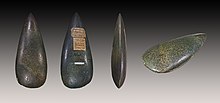Chasséen culture
| Preceded by the Pleistocene |
| Holocene Epoch |
|---|
|
ICS stages/ages (official)
|
|
Blytt–Sernander stages/ages
*Relative to year 2000 (b2k). †Relative to year 1950 (BP/Before "Present"). |
Chasséen culture is the name given to the archaeological culture of prehistoric France of the late Neolithic (Stone Age), which dates to roughly between 4500 BC and 3500 BC. The name "Chasséen" derives from the type site near Chassey-le-Camp (Saône-et-Loire).
Chasséen culture spread throughout the plains and plateaux of France, including the Seine basin and the upper Loire valleys, and extended to the present-day départments of Haute-Saône, Vaucluse, Alpes-de-Haute-Provence, Pas-de-Calais and Eure-et-Loir. Excavations at Bercy (in Paris) have revealed a Chasséen village (4000 BC - 3800BC) on the right bank of the Seine; artifacts include wood canoes, pottery, bows and arrows, wood and stone tools.
Chasséens were sedentary farmers (rye, panic grass, millet, apples, pears, prunes) and herders (sheep, goats, oxen, pigs). They lived in huts organized into small villages (100-400 people). Their pottery was little decorated. They had no metal technology (which appeared later), but mastered the use of flint.
By roughly 3500 BC, the Chasséen culture in France gave way to the late Neolithic transitional Seine-Oise-Marne culture (3100BC - 2000 BC) in Northern France and to a series of archaeological cultures in Southern France.
Time line[]

- 4000: Chasséen village of Bercy near Paris
- 4400: Chasséen village of near Toulouse.
- 4400: Appearance of Rössen culture at in Haute-Saône.
- 3190: Chasséen culture in Calvados.
- 3530: Chasséen culture in Pas-de-Calais.
- 3450: End of Chasséen culture in Eure-et-Loir.
- 3400: End of Chasséen culture in (Alpes-de-Haute-Provence).
Notes[]
See also[]
- Prehistoric France
- Rössen culture (4500 BC - 4000 BC)
- Funnelbeaker culture (4000 BC -2700 BC)
- (3400/3300 BC - 2700/2600 BC)
- Seine-Oise-Marne culture (3100BC - 2000 BC)
- Beaker culture (2800 BC - 1900 BC)
- Archaeological cultures of Western Europe
- Neolithic cultures of Europe
- Archaeological cultures in France